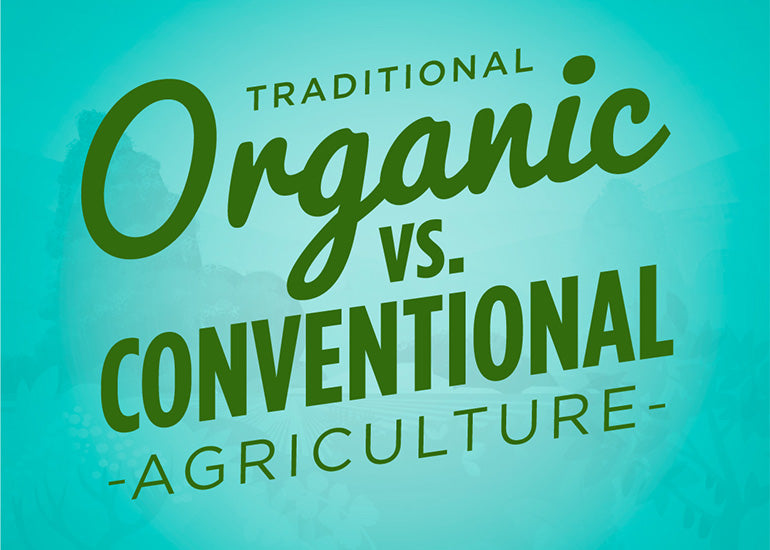Entering a grocery store nowadays, we’re used to finding the produce section separated into two distinct areas: organic and conventional (A.K.A. “non-organic”). While this is so familiar to us now that we’re shocked to find it any other way (and many of us can’t even remember a time when organic produce wasn’t an option), it wasn’t until 1990 that the USDA established regulations for certified organic produce. With this perspective, we’re able to see how young the organic industry still is, why there is so much confusion around what “organic” even means, and if it’s truly better than conventional.
Before diving into the specifics about organic vs. conventional produce, it’s valuable to take a step back and understand why the organic industry came into being in the first place. The 20th century brought about huge changes—both in the US and abroad: two world wars; the Great Depression; women gaining the right to vote; the assembly line; the invention of processed foods; increased accessibility to plastics and industrial materials; the civil rights movement; space exploration; the Internet…you get the picture.
As technology, economics, politics, culture, population density and Big Business evolved, so did our agricultural methods—moving farther away from traditional farming and into “better,” more efficient and higher-yielding practices. While one could argue that these shifts were well-intentioned and directly influenced by our wider industrial and socioeconomic growth, they also made the use of chemical pesticides and herbicides, monocropping and genetically modified organisms everyday practices. By the 1990s, this agricultural shift was so extreme that it created a need for farmers and consumers both to be able to identify and substantiate foods that were still grown the way nature intended—and thus, the “organic” industry was born.
What is Organic Agriculture?
If the produce or packaged food you buy has a USDA Organic logo on it, that means it was (or at least 95% of its ingredients were) grown in compliance with a set of strict regulations established by the US Department of Agriculture. As stated on the USDA website, these regulations qualify organic farming as “…a set of cultural, biological, and mechanical practices that support the cycling of on-farm resources, promote ecological balance, and conserve biodiversity. These include maintaining or enhancing soil and water quality; conserving wetlands, woodlands, and wildlife; and avoiding use of synthetic fertilizers, sewage sludge, irradiation, and genetic engineering.”[i]
So, what does that all mean? We often think about the benefits of eating organic as tied to our own bodies—that organic produce may be more nutritious and prevent our ingestion of chemical residues. These are both true and important reasons to eat organic, but they only scratch the surface of what organic means and why purchasing organic foods is vital for our long-term health.
At its core, organic agriculture actively respects and nourishes the health of the earth: the soil, broader ecosystems and habitats, animals, our air and our water—which is crucial considering how rapidly we’re exhausting our natural resources and harming the beings with which we share this world.
The following are fundamental practices in organic agriculture:
-
All-natural fertilizers and pest control methods.
Organic agriculture uses co-planting strategies to naturally control pests and relies on organic matter (like compost) to fertilize the soil. An alternate phrasing of this is that organic never uses chemical herbicides or insecticides to kill pests or harsh chemicals, waste water and sewage sludge as fertilizer. This is essential in maintaining the health and biodiversity of the soil, ecosystems and our food—and ensures they are free from toxic chemicals as well.
-
Always non-GMO.
Even through food may be grown without the use of genetically modified organisms (non-GMO), it does not mean that it is grown with organic agricultural methods. However, USDA organic certification does not allow the use of GMOs. This means that while non-GMO food is not always organic, certified organic food is always non-GMO.
-
Crop-rotation.
Organic agriculture rotates the types of crops it grows on a plot of land and grows cover crops, which are planted after harvesting season specifically to manage soil quality, erosion and wildlife. Both of these practices are imperative in maintaining biodiversity and healthy soil.[ii] The health of our soil impacts the health of our environment, plant and animal life in an astonishing number of ways. Primary among them is that biodiversity in soil is essential for the soil to successfully store carbon dioxide (C02), which it pulls out from our air. This directly helps slow climate change. Research by the Rodale Institute Farming Systems Trial shows that, "If only 10,000 medium sized farms in the U.S. converted to organic production, they would store so much carbon in the soil that it would be equivalent to taking 1,174,400 cars off the road, or reducing car miles driven by 14.62 billion miles."
What is Conventional Agriculture?
Conventional agriculture relies on industrialized methods and inorganic materials to grow and harvest food. These include:
Chemical pesticides and herbicides.
Spraying chemicals on crops to ward off pests and “help” them grow not only leaves residues on the conventional produce we eat, but also infiltrates the soil. When it rains, the water runoff from the soil is infused with these chemicals and is carried into our lakes, reservoirs and ocean—contaminating our water resources and slowly destroying subterranean ecosystems. To bring this a little closer to home: the USDA has estimated that 50 million people in the United States obtain their drinking water from groundwater that is potentially contaminated by pesticides and other agricultural chemicals.
-
Sewage sludge.
As detailed by the Center for Food Safety, “Beginning in the early 1990s, millions of tons of potentially toxic sewage sludge have been applied to millions of acres of America’s farmland as food crop fertilizer. Selling sewage sludge to farmers for use on cropland has been a favored government program for disposing of the unwanted byproducts from municipal wastewater treatment plants.”[v] Gross.
-
Genetically modified organisms (GMOs).
Conventional agriculture uses these to grow bigger, more resilient crops—especially soy and corn. Click learn all about why it’s a good idea to avoid GMOs.
-
Monocropping.
Instead of crop rotation, conventional agriculture grows the same crops over and over on the same plots of land. This compromises biodiversity in the soil, which perpetuates the need for chemical fertilizers, harms ecosystems, minimizes carbon storage and directly contributes to erosion.
The Verdict is In
The methods used by certified organic agriculture—which have been used for centuries and mimic nature’s design—actively maintain and bolster the health of our earth. This has endless reverberations on our physical health as well as the sustainability of our environment and natural resources.
Conventional agriculture sits on the other side of this coin. The practices it employs are geared towards producing the greatest quantity of crops as cheaply as possible, with little to no regard for how its methods deplete our earth, compromise animal welfare and their natural habitats, and affect our physical health.
Laid out in these terms, it’s clear to see the many benefits of organic agriculture over conventional farming. As a set of practices that not only grows food in synchronicity with nature but also contributes to its long-term health, organic agriculture must be the way of the future.
Click HERE to watch Part 1 of our "Understanding Organic" video series for a quick and easy way to understand the basics of why organic is better than conventional farming.
Sources:
[i] USDA, “Introduction to Organic Practices.” Accessed Aug 12, 2019. <https://www.ams.usda.gov/publications/content/introduction-organic-practices>.
[ii] USDA, “Introduction to Organic Practices – Factsheet.” Accessed Aug 12, 2019. <https://www.ams.usda.gov/sites/default/files/media/Organic%20Practices%20Factsheet.pdf>.
[iii]The Balance, “How Organic Farming Benefits the Environment.” Accessed Aug 12, 2019. <https://www.thebalance.com/environmental-benefits-of-organic-farming-2538317>.
[iv] Alavanja, Michael C.R., DR. P.H., “Pesticides Use and Exposure Extensive Worldwide.” US National Library of Medicine National Institutes of Health. Accessed Aug 12, 2019. <https://www.ncbi.nlm.nih.gov/pmc/articles/PMC2946087/#R7>.
[v] Center for Food Safety, “About Sewage Sludge.” Accessed Aug 12, 2019. <https://www.centerforfoodsafety.org/issues/1050/sewage-sludge/about-sewage-sludge>.
[vi] NSW Government Office of Environment & Heritage, “Soil Biodiversity.” Accessed Aug 12, 2019. <https://www.environment.nsw.gov.au/topics/land-and-soil/soil-degradation/soil-biodiversity>.
AUTHOR BIO
Meredith Rosenbluth is an astrologer, mindfulness practitioner and educator who is an activator of consciousness and conduit of healing. Raised in Los Angeles, CA, she has a background in contemporary art, holistic nutrition, teaching and writing. Being confronted by darkness within herself throughout her professional eras led her down a decade-long path of internal inquiry, therapy, spiritual seeking and transformation. Drawing upon her varied expertise, she guides people in cultivating bodily awareness, regulating the nervous system, shifting internal thought patterns, identifying core wounds and self-protective coping mechanisms, and living into more compassionate, aligned, and self-loving ways of being. She currently resides in Asheville, NC, where she works with clients both in person and via online sessions.
)
